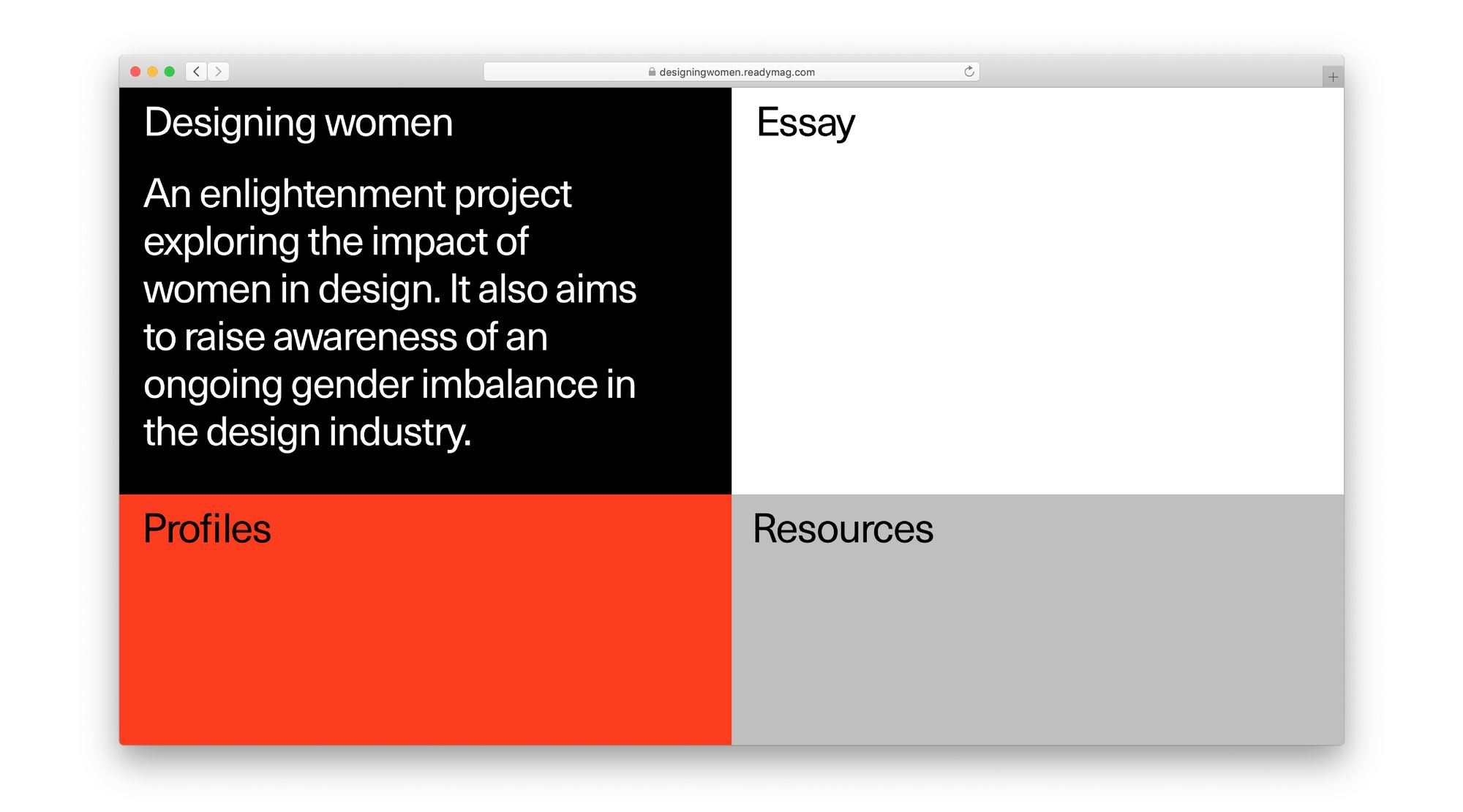Designing Women: In-House Histories
Designing women is an educational project by Readymag exploring the impact of women in design. It also aims to raise awareness of an ongoing gender imbalance in the design industry. We publish a chapter of the essay by Madeleine Morley below.

Designing women is an educational project by Readymag exploring the impact of women in design. It also aims to raise awareness of an ongoing gender imbalance in the design industry. We publish a chapter of the essay by Madeleine Morley below.
In-House Histories
In design today, women and men exist in the same institutions and businesses, and they emerge from the same educational systems. Yet their experiences within these structures are very divergent. In the past, gendered experiences in the field of graphic design were even more different. During the early twentieth century in Europe and North America, many art schools turned their emphasis towards training a professional class of designers; traditional gender roles meant women were sidelined, as they were considered less suitable for management roles. It should be remembered that in many countries, women were only given the right to vote in the early and mid-twentieth century, and their participation in the labor force has been historically determined by men in most trades across the world.
Women existed in the design trade in the early and mid-twentieth century, but they were largely invisible — hired to carry out laborious grunt work instead of client-facing, big picture thinking. Historically, for example, non-unionized young women were hired to typeset or clean metal fonts — forms of maintenance work essential to production yet undervalued. Women were often “office girls,” and few held top titles, such as art director or creative director. Historically feminized tasks and processes — repetitive, detail oriented labor like sewing, cleaning, and organizing — were given to women, contributing to a gendered distribution of roles in the field, which separated maintenance labor from creative work and expertise.

“At agencies in South Korea in the ’60s and ’70s, women were also often hired to do detailed work,” says Na Kim, a graphic designer from Seoul and one of four curators behind The W Show: A List of Graphic Designers, a 2017 exhibition highlighting Korean women in design past and present. “Women wouldn’t be the ones to design a book cover for instance. Instead, they’d be the ones to layout the text.”
Mira Malhotra, a graphic designer and founder of Studio Kohl in Mumbai, and a publisher of feminist comics journal Bystander, observes a similar distribution historically in India: “In the past, graphic design has been more associated with advertizing — and advertizing was very male-dominated here,” she says. It’s in the more decorative, detailed arena of children’s book illustration where you’ll traditionally find “a ton of women,” says Malhotra.

The London-based design educator Ruth Sykes — who’s behind the research project ‘Graphics UK Women’ — emphasizes that women have been far more likely to work in-house at large agencies than in prominent independent studios. Benefits such as insurance schemes and parental leave policies could be contributing factors. “And traditionally it’s been the man’s role to operate independently,” says Sykes. As a result, women’s contributions to graphic design have remained in the dark — they haven’t been thoroughly recorded, archived, and recounted.
“When graphic design historians collate history books, they’re often more likely to write about work from independent design agencies that had a more varied and supposedly cutting-edge output,” says Sykes. “Yet because women were more likely to find work within in-house agencies — producing great work but work which was not seen as creatively valuable as that from the independent agencies — it’s been less likely to be written about.”
Additionally, and for similar reasons, women’s graphic design work hasn’t been archived as meticulously as that by independent, male practitioners; often archivists only preserve work that seems significant, or that has been signed, and historically men were much more likely to sign work than women. Sykes also notes that, likely due to their skills, graphic designers love producing monographs, but the conventional economics of monograph making mean that readers want an array of pictures of work, and women might not have had the length of career to fill a book.
“When a lecturer asks students to do a history project on a graphic designer, there literally aren’t enough monographs on women graphic designers in the library to go around a class of say 30 students,” says Sykes.

So-called craft processes have also been classified as distinct from modern design. “Through this division, the histories and practises of indigenous cultures, as well as those of women, have been relegated,” says Anja Neidhardt, a design writer and co-creator of the Swiss research group Depatriarchise Design. “A lot of design by women — including domestic labor like knitting, sewing, and weaving — has been excluded from design history.”
Historically, there has been a deeply entrenched hierarchy between men as creators and women as muses; the creative output of women has therefore not been taken as seriously when it is considered at all.